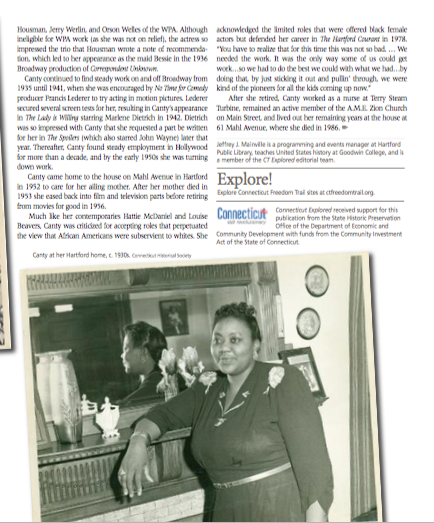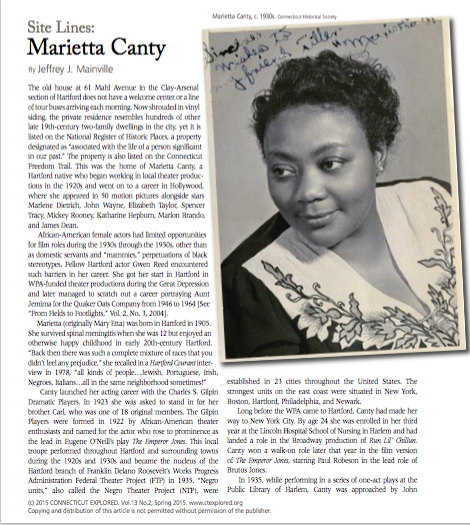(c) Connecticut Explored, Spring 2015
Subscribe/Buy the Issue!
The old house at 61 Mahl Avenue in the Clay-Arsenal section of Hartford does not have a welcome center or a line of tour buses arriving each morning. Now shrouded in vinyl siding, the private residence resembles hundreds of other late 19th-century two-family dwellings in the city, yet it is listed on the National Register of Historic Places, a property designated as “associated with the life of a person significant in our past.” This was the home of Marietta Canty, a Hartford native who began working in local theater productions in the 1920s and went on to a career in Hollywood, where she appeared in 50 motion pictures alongside stars Marlene Dietrich, John Wayne, Elizabeth Taylor, Spencer Tracy, Mickey Rooney, Katharine Hepburn, Marlon Brando, and James Dean.
African-American female actors had limited opportunities for film roles during the 1930s through the 1950s, other than as domestic servants and “mammies,” perpetuations of black stereotypes. Fellow Hartford actor Gwen Reed encountered similar barriers in her career. She got her start in Hartford in WPA-funded theater productions during the Great Depression and later managed to scratch out a career portraying Aunt Jemima for the Quaker Oats Company from 1946 to 1964 [See “From Fields to Footlights,” Vol. 2, No. 3, 2004].
Marietta (originally Mary Etta) was born in Hartford in 1905. She survived spinal meningitis when she was 12 but enjoyed an otherwise happy childhood in early 20th-century Hartford. “Back then there was such a complete mixture of races that you didn’t feel any prejudice,” she recalled in a Hartford Courant interview in 1978, “all kinds of people…Jewish, Portuguese, Irish, Negroes, Italians…all in the same neighborhood sometimes!”
Canty launched her acting career with the Charles S. Gilpin Dramatic Players. In 1923 she was asked to stand in for her brother Carl, who was one of 18 original members. The Gilpin Players were formed in 1922 by African-American theater enthusiasts and named for the actor who rose to prominence as the lead in Eugene O’Neill’s play The Emperor Jones. This local troupe performed throughout Hartford and surrounding towns during the 1920s and 1930s and became the nucleus of the Hartford branch of Franklin Delano Roosevelt’s Works Progress Administration Federal Theater Project (FTP) in 1935. “Negro units,” also called the Negro Theater Project (NTP), were established in 23 cities throughout the United States. The strongest units on the east coast were situated in New York, Boston, Hartford, Philadelphia, and Newark.
Long before the WPA came to Hartford, Canty had made her way to New York City. By age 24 she was enrolled in her third year at the Lincoln Hospital School of Nursing in Harlem and had landed a role in the Broadway production of Run Lil’ Chillun. Canty won a walk-on role later that year in the film version of The Emperor Jones, starring Paul Robeson in the lead role of Brutus Jones.
In 1935, while performing in a series of one-act plays at the Public Library of Harlem, Canty was approached by  John Housman, Jerry Werlin, and Orson Welles of the WPA. Although ineligible for WPA work (as she was not on relief), the actress so impressed the trio that Housman wrote a note of recommendation, which led to her appearance as the maid Bessie in the 1936 Broadway production of Correspondent Unknown.
John Housman, Jerry Werlin, and Orson Welles of the WPA. Although ineligible for WPA work (as she was not on relief), the actress so impressed the trio that Housman wrote a note of recommendation, which led to her appearance as the maid Bessie in the 1936 Broadway production of Correspondent Unknown.
Canty continued to find steady work on and off Broadway from 1935 until 1941, when she was encouraged by No Time for Comedy producer Francis Lederer to try acting in motion pictures. Lederer secured several screen tests for her, resulting in Canty’s appearance in The Lady is Willing starring Marlene Dietrich in 1942. Dietrich was so impressed with Canty that she requested a part be written for her in The Spoilers (which also starred John Wayne) later that year. Thereafter, Canty found steady employment in Hollywood for more than a decade, and by the early 1950s she was turning down work.
Canty came home to the house on Mahl Avenue in Hartford in 1952 to care for her ailing mother. After her mother died in 1953 she eased back into film and television parts before retiring from movies for good in 1956.
Much like her contemporaries Hattie McDaniels and Louise Beavers, Canty was criticized for accepting roles that perpetuated the view that African Americans were subservient to whites. She acknowledged the limited roles that were offered black female actors but defended her career in The Hartford Courant in 1978. “You have to realize that for this time this was not so bad. … We needed the work. It was the only way some of us could get work…so we had to do the best we could with what we had…by doing that, by just sticking it out and pullin’ through, we were kind of the pioneers for all the kids coming up now.”
After she retired, Canty worked as a nurse at Terry Steam Turbine, remained an active member of the A.M.E. Zion Church on Main Street, and lived out her remaining years at the house at 61 Mahl Avenue, where she died in 1986.
Jeffrey J. Mainville is a programming and events manager at Hartford Public Library, teaches United States history at Goodwin College, and is a member of the CT Explored editorial team.
![]() Connecticut Explored received support for this publication from the State Historic Preservation Office of the Department of Economic and Community Development with funds from the Community Investment Act of the State of Connecticut.
Connecticut Explored received support for this publication from the State Historic Preservation Office of the Department of Economic and Community Development with funds from the Community Investment Act of the State of Connecticut.
Explore!
“Gwen Reed: From Fields to Footlights,” May/Jun/Jul 2004
Read all of our stories about Notable Connecticans on our TOPICS page
Read all of our stories about the African American experience in Connecticut on our TOPICS page

